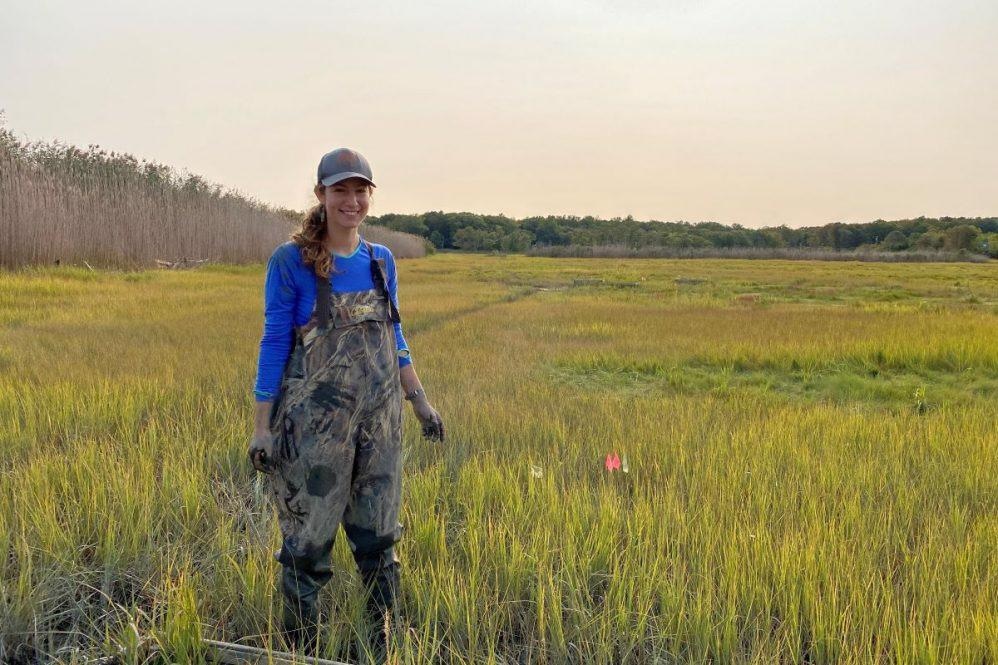Adding the correct amount of sediment to the surface of a Connecticut salt marsh safeguards coastlines despite quick sea level rise, says a new study performed by the University of Connecticut (UConn).
 Anna Puchkoff in the field conducting a study on sediment distribution in Connecticut wetlands. Image Credit: Contributed photo.
Anna Puchkoff in the field conducting a study on sediment distribution in Connecticut wetlands. Image Credit: Contributed photo.
The addition of sediment protects coastlines by encouraging rapid plant growth, researchers from the University of Connecticut report in a new study published recently in the Environmental Engineering journal.
The addition of sediment on top of salt marshes helps them remain above sea level as it is in constant increase. Anna Puchkoff and Beth Lawrence from UConn’s College of Agriculture, Health and Natural Resources performed a study on how the supplement of sediment could help restore salt marshes present in Connecticut. For Puchkoff’s study, she utilized sediment that was dredged from the Long Island Sound by the Guilford Yacht Club in the vicinity.
My goal was to also reduce project costs and replicate a real-life restoration scenario where in many cases, you have to work with what you’ve got or what the available resources at hand are. This was a core principle in my research, since using dredged material from marinas is common and disposal is costly.
Anna Puchkoff, College of Agriculture, Health and Natural Resources, University of Connecticut
Puchkoff recently earned a master’s degree from the Department of Natural Resources and the Environment at UConn.
Rather than transporting the sediment to a dumping site, Puchkoff collaborated with the yacht club to utilize their sediment to restore a salt marsh on their property and decrease charges of sediment transportation.
Various amounts of sediment were added by Puchkoff and Lawrence to the marsh — measuring around 5, 10 and 15 cm — to determine how much sediment is rightly enough. Insufficient sediment would probably not have a fairly large effect to outbalance the cost of restoration, and too much would destroy the plants and the marsh.
Eventually, they discovered just the proper amount. As per their outcomes, 5 to 7 cm of sediment was found out to be the ideal amount to enhance plant growth, thereby keeping the marsh afloat.
The goal is to find the intersection of where costs are low, sediment re-application frequency is low, and recovery is high. Our results indicated that in two years, this amount had the greatest benefit to meet these goals. Ten centimeters may be a good alternative for a longer time frame.
Anna Puchkoff, College of Agriculture, Health and Natural Resources, University of Connecticut
Puchkoff explains that the additional sediment has the extra advantages of decreasing the existence of plant toxins like sulfides, and helps the marsh take up carbon from the air.
This study benefits coastlines in the Northeast to stay ahead of increasing sea levels, by utilizing methods that are already in place in other areas.
“Salt marshes are drowning due to rising sea levels, and the Northeastern coastlines are experiencing higher rates of sea-level rise than the global average,” explained Lawrence, an assistant professor in the Department of Natural Resources and the Environment and Puchkoff’s advisor.
The management method of introducing sediment to coastal marshes is normally employed along the Gulf Coast of the United States but is utilized in the Northeast only in recent times.
I hope this information helps propel coastal wetland restoration projects from an idea to execution and will provide land managers with guidance on how to realistically and effectively implement this approach for the Connecticut coast.
Anna Puchkoff, College of Agriculture, Health and Natural Resources, University of Connecticut
Journal Reference:
Puchkoff, A. L & Lawrence, B. A (2022) Experimental sediment addition in salt-marsh management: Plant-soil carbon dynamics in southern New England. Ecological Engineering. doi.org/10.1016/j.ecoleng.2021.106495.
Source: https://uconn.edu/